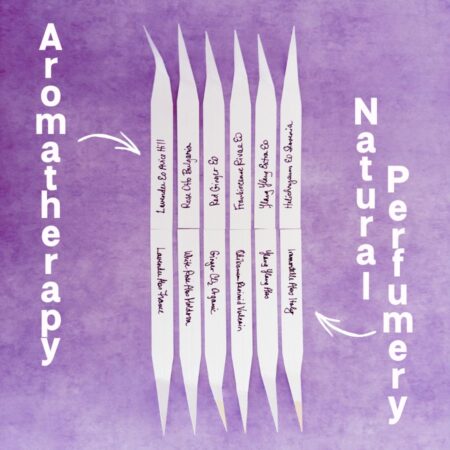
Aromatherapy vs Natural Perfumery Mouillettes by Gabrielle
Aromatherapy and natural perfumery grow from the same garden, but they’re cultivated for different purposes.
Aromatherapy is, at its core, therapy through aroma. Essential oils are chosen with precision for their ability to ease anxiety, soothe a sore muscle, or lull an overstimulated brain. The scent is important, yes, but it’s the sidekick – not the star.
Natural perfumery, on the other hand, is unabashedly about the art of fragrance. The goal is to create something beautiful, moving, and memorable. If it also helps you unwind after a long day? Wonderful. But that’s gravy, not the goal.
Aromatherapists might pair lavender and frankincense to ease a headache. A natural perfumer might pair them because they’re chasing a particular kind of cool, resinous hush in the drydown. The same ingredients, utterly different intentions.
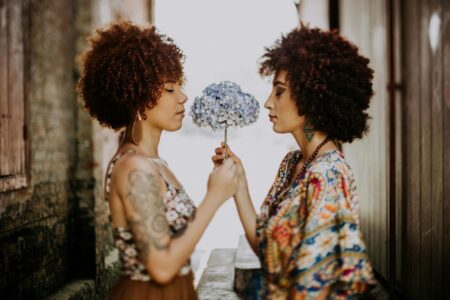
Two women & hydrangea, Matheus Bertelsmann, Pexels
Despite their differing missions, aromatherapy and natural perfumery share a fascinating, and sometimes fuzzy, middle ground: our emotional response to scent.
Both disciplines work with the olfactory system – the part of your brain that processes smell and just so happens to be deeply intertwined with memory and emotion. That’s not woo-woo; that’s neuroscience.
Research from places like the Monell Chemical Senses Center shows that a pleasant scent can trigger real psychological shifts – sometimes due to the compounds involved, and sometimes because of your own scent-memory associations (hello, childhood summers and Grandma’s rose garden). This is the realm of aromacology – sometimes described as “aroma psychology” – a term coined to distinguish emotional responses to scent from the more clinical aims of aromatherapy.
So yes, a rose oil can soothe the spirit in an aromatherapist’s toolkit and set the mood for a romantic evening in a perfumer’s blend. Citrus oils can lift your mood whether they’re part of a massage blend or spritzed on before brunch. Context is everything.
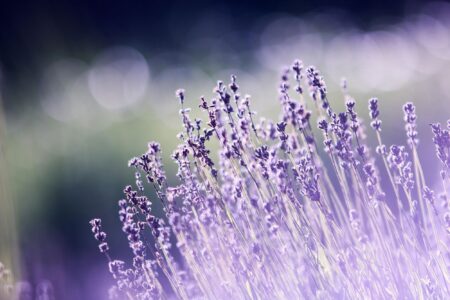
Lavender Field, Palo Cech, Pexels
Essential oils have been used in healing practices for centuries, and many have the scientific backing to show why. Aromatherapists turn to these materials not for their artistry, but for their chemistry. Here are a few standouts:
Lavender Essential Oil (Lavandula angustifolia) – A classic for stress and anxiety. Rich in linalool and linalyl acetate, lavender has been shown in clinical studies to have measurable calming effects.
Rose Otto (Rosa damascena) – Celebrated for emotional balance. Compounds like citronellol and geraniol contribute to its anti-anxiety and analgesic effects.
Ylang-Ylang Essential Oil (Cananga odorata) – Known for its ability to reduce blood pressure and promote relaxation. Its sweet, exotic scent is as psychologically potent as it is pleasant.
Frankincense Essential Oil (Boswellia carterii) – Traditionally used for inflammation and spiritual grounding. It slows the breath and quiets the mind, making it a favorite in meditative blends.
Helichrysum Essential Oil (Helichrysum italicum) – Also called “Immortelle,” this oil supports skin healing and reduces inflammation. Its therapeutic value is backed by both tradition and recent research.
Ginger Essential Oil (Zingiber officinale) – A go-to for nausea and circulation. Its warming, anti-spasmodic qualities also make it a favorite for easing sore muscles and menstrual discomfort.
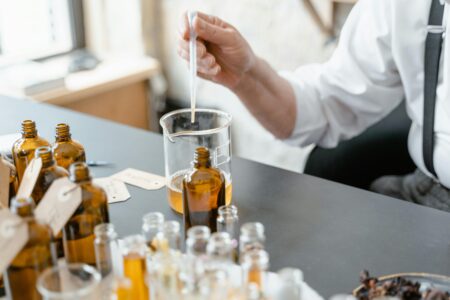
Perfumer dispensing oil into beaker, Mart Productions, Pexels
Natural perfumery uses many of the same raw materials – but here, the magic lies in how they smell, blend, and evolve over time. The goal isn’t to heal the body; it’s to move the soul (or, at the very least, get you complimented in an elevator).
Perfume creation is part art, part science, and part sorcery. Natural perfumers think in terms of top, heart, and base notes – how an oil performs, how long it lingers, and what it does when it mingles with 20 or 30 other ingredients.
Here’s how the same ingredients might be used in a perfume:
Lavender EO – That crisp, herbal brightness is perfect as a top note in classic colognes or fougère structures.
Rose Absolute – Deep, lush, and complex, it’s a quintessential heart note – often the emotional core of a romantic fragrance.
Ylang-Ylang – A tropical knockout used for its heady sweetness and ability to round out the heart of a blend.
Frankincense/Olibanum – Earthy and resinous, it anchors a perfume as a base note and fixative, lending spiritual depth and longevity.
Helichrysum/Immortelle – With its maple-honey undertones, this oil is often used in small amounts for warm, hay-like depth in the base.
Ginger – Sharp, spicy, and energetic. It can add a burst of brightness to a citrus blend or a gourmand’s spicy kick.
Natural perfumers get to color with a much bigger box of crayons: essential oils, absolutes, CO₂ extracts, and more. And unlike aromatherapists, who usually keep their blends simple for safety and clarity, perfumers might use dozens of ingredients to build a rich, layered experience. It’s alchemy with a nose.
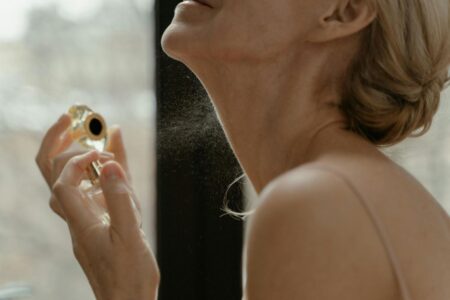
Woman spraying perfume, Ron Lach, Pexels
The essential difference between aromatherapy and natural perfumery boils down to intent.
Are you using an oil because you want to lower your blood pressure? Or because you’re building the next cult fragrance? In recent years, the two worlds have begun to blur a bit – “functional fragrances” promise therapeutic effects and aesthetic pleasure – but the heart of each discipline remains distinct.
Aromatherapy is guided by wellness, safety, and science. Natural perfumery is guided by beauty, emotion, and the intangible allure of a well-turned blend. Both can be profound. Both can be powerful. And both remind us just how deeply scent can touch the human experience.
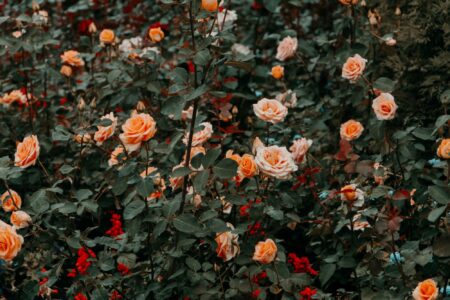
Rose Garden, Irina Iriser, Pexels
With aromatherapy and natural perfumery, there are two paths through the same garden; you don’t have to choose sides. The essential oils used in aromatherapy and natural perfumery come from the same plants, after all. It’s the purpose – the why behind the blend – those changes everything.
One bottle might ease a migraine; another might evoke your most romantic summer. A single drop of rose could be medicine – or metaphor. That’s the magic of scent.
Whether you’re seeking comfort or creativity, healing or high art, nature’s aromatic gifts are ready. All you need is a nose – and a little clarity about what you’re sniffing for.
–Gabrielle Durand, Guest Contributor for www.cafleurebon.com
After decades in the corporate world, Gabrielle traded spreadsheets for scent strips. As the nose behind On The Nose Perfumes, she now spends her days blending botanicals, teaching perfume lovers about naturals, and occasionally mumbling to her bottles like they’re coworkers. She’s fine with that.
Read her Profile in American Perfumery here
All photos are owned by On The Nose Perfumes, unless otherwise stated.
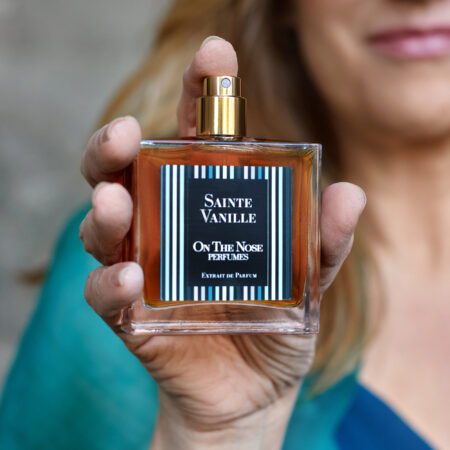
Gabrielle Durand of On The Nose Perfumes holding Sainte Vanille
As a thank you for enjoying Gabrielle’s Notes from the Lab, On The Nose Perfumes will be offering a 15 ml bottle of Sainte Vanille (a $140 value)to give to one lucky random registered ÇaFleureBon reader IN THE CONTINENTAL US ONLY. Please register here or your comment will not count. To be entered, in the comments section below, tell us what you enjoyed about Gabrielle’s perspective about aromatherapy vs. natural perfumery, and share the one natural material you never get tired of smelling in perfume. Draw closes 4/08/2025.
Sainte Vanille notes: Aged, handmade Madagascan vanilla tincture and natural vanillin extracted from cloves, Frankincense Rivae, myrrh absolute, Cyprian labdanum, Galbanum resin, kumquat, osmanthus, rose, iris, jasmine, and elemi
PLEASE VISIT ON THE NOSE PERFUMES Online Shop AND SUPPORT OUR ARTISAN PERFUMERS
Please like The Series on Facebook here and your comment will count twice.
Follow us on Instagram @cafleurebonofficial @onthenoseperfumes
This is our Privacy Policy
We announce the winners only on site and on our Facebook page, so “like” Cafleurebon and use our Blog FEED… or your dream prize will be just spilled perfume
